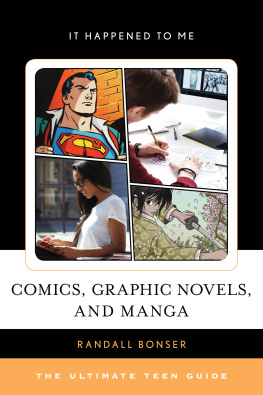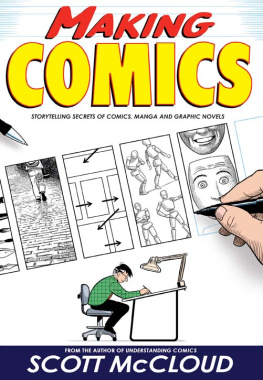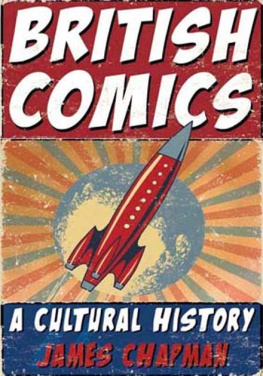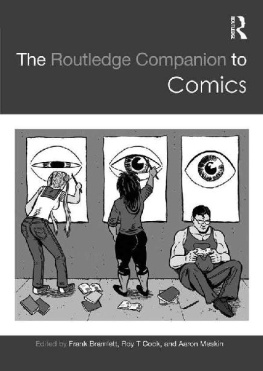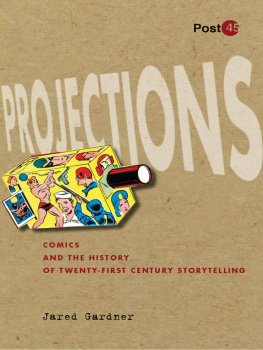Arguing COMICS
Arguing COMICS
Literary Masters on a Popular Medium
EDITED BY JEET HEER AND KENT WORCESTER

www.upress.state.ms.us
The University Press of Mississippi is a member of the Association of American University Presses.
Copyright 2004 by University Press of Mississippi
All rights reserved
Manufactured in the United States of America
12 11 10 09 08 07 06 05 04 4 3 2 1

Library of Congress Cataloging-in-Publication Data
Arguing comics : literary masters on a popular medium / edited by Jeet Heer and Kent Worcester.
p. cm.
Includes bibliographical references and index.
ISBN 1-57806-686-7 (cloth : alk. paper)ISBN 1-57806-687-5 (pbk. : alk. paper)
1. Comic books, strips, etc.History and criticism. I. Heer, Jeet. II. Worcester, Kent, 1959
PN6710.A84 2004
741.509dc22
2004012865
British Library Cataloging-in-Publication Data available
Contents
Introduction
Illustrated storytelling in general, and comic strips and comic books in particular, have long excited fierce controversy. In 1846 the English poet William Wordsworth penned a sonnet, Illustrated Books and Newspapers, that inveigled against this vile abuse of pictured page:
DISCOURSE was deemed Mans noblest attribute,
And written words the glory of his hand;
Then followed Printing with enlarged command
For thoughtdominion vast and absolute
For spreading truth, and making love expand.
Now prose and verse sunk into disrepute
Must lacquey a dumb Art that best can suit
The taste of this once-intellectual Land.
A backward movement surely have we here,
From manhood, back to childhood; for the age
Avaunt this vile abuse of pictured page!
Must eyes be all in all, the tongue and ear
Nothing? Heaven keep us from a lower stage! (Wordsworth 16)
Must eyes be all in all? In the century and a half or so since Wordsworth posed this question, numerous writers and intellectuals have endorsed, amended and contested his claim that illustration and comics are backward movement that substitute visual excitement for the tongue and ear of conversation and text. In the twentieth century, comic strips and comic books both played starring roles in recurrent cultural conflicts over the pictured page. Individual comic strips, comic books and comics creators and publishers on occasion commanded intense public scrutiny, as did the comic strip and the comic book as things in themselves. Arguments over specific images, characters and storylines spilled over into larger controversies about the validity of illustration and cartooning in the service of narration, entertainment and social commentary. At different times, political and social figures claiming to speak for children, parents and voters promised to investigate the form and content of comics. But then, so did university and non-university intellectuals, even prior to the cultural turn (Bender 41) of the 1970s and 1980s.
This volume seeks to recover the comics writings of influential reviewers and criticsliterary masters, if you willwho wrote on comics during the long epoch between the introduction of cheaply printed images and the consolidation of popular culture studies. In the early and mid-twentieth century, the most reflective and provocative comics commentary usually emanated from freelance intellectuals rather than civic activists or academic researchers (psychologists and educationalists were applying behavioralist axioms to comics long before literature and history departments began awarding MAs and PhDs for comics research). As this collection makes clear, a fair number of film critics, art critics, journalists and essayists thoughtfully, if not always sympathetically, paused over comics before returning to their regular preoccupations. Comic strips and comic books attracted not only opponents and disinterested clinicians, but also, occasionally, critics. It is this back catalog of compelling commentary and analysis that this volume brings to life for a contemporary readership.
Intellectual responses to comics tend to fall into distinct categories. This volume opens with essays by Sidney Fairfield, Annie Russell Marble and Ralph Bergengren, who viewed fin de siecle illustrated material with alarm. Their concerns mirror those expressed by William Wordsworth, whom Marble approvingly cites. (Interestingly, their complaints broadly coincided with the introduction of comic strips in daily and Sunday newspapers, just as Wordsworths sonnet broadly coincided with the early mechanization of images.) A generation after Fairfield and company issued their elegant salvos, Gilbert Seldes, Dorothy Parker, H.L. Mencken and others revalued the cartoon arts as part of a more generous reappraisal of the American vernacular. Seldes The Seven Lively Arts (1924) became particularly well known for its sympathetic stance toward comic strips and other popular arts, while Thomas Manns 1926 introduction to Frans Masereels picture novel identified sequential storytelling with the spirit of democracy. There is very much the sense of a conscious break with a stereotypically Victorian emphasis on cultural standards and canons in these works.
By way of contrast, New York intellectuals like Clement Greenberg, Irving Howe, Harold Rosenberg, Delmore Schwartz and Robert Warshow embraced neither Victorian values nor, for the most part, popular culture. As art historians, Greenberg and Rosenberg wrote insightfully about the few editorial cartoonists they favored, but made it clear that the mass of illustration and comics were not to be taken seriously. Film critic and essayist Robert Warshow warily scrutinized Krazy Kat and horror comics, while Irving Howe and Delmore Schwartz located comics within the morass of mass culture. Postwar mavericks like Manny Farber, Leslie Fiedler, Marshall McLuhan, Walter Ong and Donald Phelps read Partisan Review, and possibly Politics as well, where Irving Howes tart commentary on mass culture first appeared. Their writings nevertheless offered a conscious departure from the cultural pessimism identified with the metropolitan little magazines. The early 1950s observations of C. L. R. James, and Umberto Ecos 1962 essay on Superman, which closes the volume, represent a liminal space in comics criticism, marking the terrain between freelance criticism and contemporary cultural studies.
The earliest critics of reproduced images were responding to the greater availability of illustrated material made possible via such processes as lithography, photo-engraving and chromolithography. The latter became widely adopted by newspaper and magazine editors and publishers in the 1840s and 1850s. Between the middle and end of the 1800s, the pace of technological innovation in image making accelerated. As Jim Cullen notes, by the end of the century various means of visual reproduction had proliferated to the point of being woven into the fabric of everyday life (Cullen 115). While Cullen specifically refers to daguerreotypes (early photographs), postcards, calendars and woodcut photoengravings, comic strips and eventually comic books formed an integral aspect of an expanding universe of visually oriented mass production.
Those who wrote about comics in the tradition of William Wordsworth objected to any effort to place commercial images on an equal footing with text. The deeds that are conspicuous, the ideas that are garish, the literature that is episodic and pictorial, gain the popular favor, complained essayist Annie Russell Marble in 1903. Comment is needless upon the supremacy of the pictorial journal, and upon the scanty discrimination, among the mass of readers, as to literary or artistic merits. (297) Ralph Bergengren, writing in the
Next page

